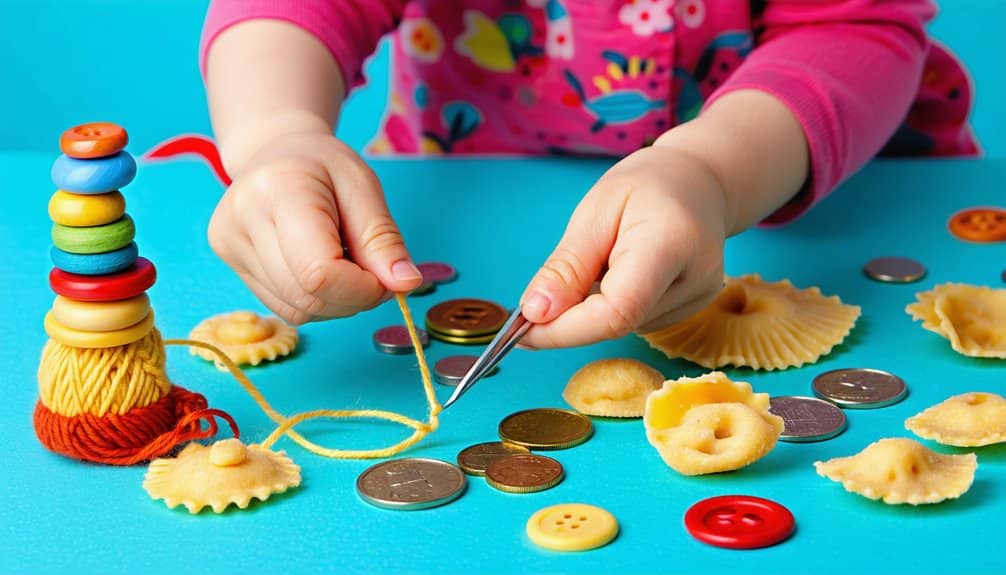Key Takeaways
- Repurposing rubber bands, straws, and Q-tips can creatively enhance fine motor skills like hand strength and pincer grasp.
- Cutting straws and stretching rubber bands are practical exercises for boosting hand-eye coordination and muscle strength.
- Threading Q-tips through a colander is a creative way to improve finger dexterity using household items.
- Everyday tasks like buttoning clothes, twisting bottle caps, and tearing tape can be used to develop fine motor skills.
- Advanced coordination exercises using household items, such as threading beads and tracing shapes, can significantly improve hand-eye coordination.
Importance of Fine Motor Skills
While many may overlook the significance, fine motor skills play an integral role in a child’s development and success in different tasks such as writing, coloring, and self-care activities. These skills, which involve the use of smaller muscle groups, especially in the hands and fingers, also contribute to a child’s academic success.
Engaging children in fine motor activities using everyday household items can be an effective, cost-friendly strategy to improve fine motor skills. This not only boosts hand dexterity and coordination but also complements school-based interventions. For instance, playing with dough, threading string through pasta, or stacking cups can all serve as engaging, beneficial activities.
Furthermore, everyday household items present a readily accessible resource for such activities, making them practical for day-to-day routines. By incorporating fine motor activities into a child’s daily life, parents and caregivers can facilitate the development of these vital skills in a structured yet enjoyable manner.
Early detection and intervention are vital in managing motor delays. They are often achieved through the watchful eyes of parents or caregivers who observe signs of difficulty in tasks such as holding pencils or using scissors (early intervention).
Safety Considerations for Activities
Safety should remain a paramount consideration when strengthening a child’s fine motor skills through household activities. It is vital always to supervise children during these activities to prevent accidents or injuries. This oversight ensures that the child engages safely and productively with household items, maximizing their learning while minimizing risks.
Moreover, the choice of household items used for fine motor activities should be age-appropriate and safe for children. Be especially cautious with activities that involve small objects, as they may pose a choking hazard, notably for younger children. Checking for sharp edges or potential dangers in these items is an extra safety consideration that cannot be overlooked.
Providing clear instructions and guidance promotes safe engagement in fine motor activities. Children need to understand how to interact with the materials and the expected outcomes of the activities. This clarity reduces the chances of misuse, thereby enhancing the safety of their learning environment.
It is also worth noting that these activities can serve as a form of pediatric occupational therapy, fostering the development of fine motor skills, especially in children experiencing developmental delays.
Activities With Fruits and Food

Shifting our focus from safety aspects, we now examine a series of activities that incorporate fruits and food items, which can play a significant role in improving a child’s fine motor skills. Simple tasks such as peeling a banana, twisting open a clementine, or extracting grapes from their stems can be great ways to develop talent and hand strength.
Strategically using household items such as small snack containers and zipper snack bags can enhance hand-eye coordination while also promoting independence. Self-feeding, a vital life skill, also strengthens fine motor development.
Moreover, children can engage with fruits during snack preparation. Cutting small food items under adult supervision not only prevents choking hazards but also enhances fine motor skills. It’s a practical way to integrate learning and daily routines.
Incorporating these activities into a child’s day encourages them to interact with fruits and food engagingly. It serves as a reminder that even everyday household items can become valuable tools in the development of fine motor skills. This helps in fostering a sense of achievement and skill mastery in children.
Utilizing the principles of the DIR/Floortime model, these activities can also help children improve their sensory modulation and cognitive development while building a solid emotional connection through meaningful play.
Creative Uses of Household Items
Turning our attention to another potential wealth of resources, let’s consider everyday household items like rubber bands, straws, and Q-tips. These everyday items are often overlooked for their potential to improve children’s fine motor skills. Repurposing these household items to boost fine motor abilities can be both cost-effective and practical, providing an accessible means to facilitate the development of hand-eye coordination, finger dexterity, and hand strength.
| Household Item | Activity | Skill Developed |
|---|---|---|
| Rubber Bands | Stretching over a small box | Hand strength, pincer grasp |
| Straws | Cutting into different lengths | Hand-eye coordination, pincer grasp |
| Q-tips | Threading through a colander | Finger dexterity, pincer grasp |
Cutting straws into small segments, for instance, not only promotes fine motor control but also provides an opportunity to make a mouth and tongue exercise enjoyable. Stretching rubber bands is a fun, acceptable motor activity that challenges hand strength and encourages a pincer grasp. Likewise, threading Q-tips through the holes of a colander is a resourceful way to promote finger dexterity. These creative uses of household items are not only practical but also make fine motor skill development enjoyable and accessible. Furthermore, activities like these can also support the development of social skills in children, as they can be used in group settings to encourage collaboration and communication.
Paper-Based Fine Motor Activities

Turning our attention to paper-based fine motor activities, we find a wealth of options readily available in most homes. From the intricate folds of origami, which improve hand-eye coordination and precision, to the simple act of tearing tissue paper and reforming it into small balls, these activities not only engage the mind but also strengthen hand muscles. In addition, the childhood favorite of creating paper airplanes can be a fun and practical way to promote fine motor skills. Moreover, fine motor activities such as these play a crucial role in developing self-care skills in children, as they enhance their ability to perform tasks like dressing and eating independently.
Origami Folding Skills
While often seen as a simple hobby, origami folding offers a practical and enjoyable way to refine fine motor abilities. The intricate and precise folds needed in origami help to improve finger dexterity and hand control while also nurturing patience and attention to detail in delicate motor tasks. Furthermore, origami activities provide a distinct way to enhance spatial awareness and bolster cognitive skills.
To utilize the advantages of origami, consider the following suggestions:
- Start Easy: Begin with basic shapes and gradually introduce more intricate designs. This assists in developing progressively hand-eye coordination and spatial awareness.
- Encourage Patient Practice: Advocate for repeated practice of the same design for mastery and to enhance finger dexterity.
- Establish an Origami Corner: Designate a space for origami activities. This can inspire individuals to experiment and create regularly, supporting creativity and critical thinking.
Incorporating origami into your fine motor activities repertoire can offer numerous benefits that go beyond the development of motor skills. As a tool for nurturing creativity, critical thinking, and cognitive skills, origami serves as a versatile and valuable asset in promoting overall growth.
Tear and Tissue Crafts
Taking a slightly different approach to paper-based activities, tear and tissue crafts offer a unique opportunity to develop fine motor skills further. Tearing tissue paper, an activity that involves both strength and precision, is incredibly beneficial. It can be a fun and creative way for children to work on their finger dexterity and bilateral coordination.
Moreover, these crafts are not restricted to tearing alone. Hand manipulation skills are improved when children are encouraged to pinch tissue paper into small balls, a task that requires careful control and coordination. The flexibility and lightness of tissue paper make it an excellent material for such exercises.
Creasing tissue paper for crafts like origami can additionally enhance hand-eye coordination. However, these crafts are not just about motor skills development; they also nurture creativity. Using tissue paper for activities like collage-making allows children to experiment with color, texture, and design, all while refining their fine motor abilities.
In essence, tear and tissue crafts are a simple, affordable, and effective way to promote fine motor development. They use everyday household items and can be tailored to fit different skill levels, making them accessible to all.
Paper Airplane Creations
Numerous paper-based activities can aid in the development of fine motor skills, and creating paper airplanes is a prime example.
As a fun and involving Fine Motor Activity Idea, paper airplane creations utilize everyday household items to improve fine motor skills. This activity enables children to strengthen their hands while folding and launching the planes. While seemingly playful, it is an effective and practical way of enhancing hand-eye coordination, finger dexterity, and spatial awareness.
Furthermore, it encourages creativity and problem-solving skills as children experiment with different folding techniques to see which design flies the best. Adding to the fun, children can decorate their planes with markers or stickers, introducing an artistic element to the activity.
Here are three engaging aspects of this activity:
- Hand Strengthening: The precise folds required in making paper airplanes engage the small muscles in the hands, enhancing their strength and agility.
- Spatial Awareness: Understanding how folds and creases impact the flight of the airplane promotes spatial thinking.
- Artistic Expression: Decorating the airplanes allows for individual expression and creativity while improving fine motor control.
Tools for Skill Development
In the domain of skill development, everyday household items such as rubber bands, straws, and Q-tips can be effectively utilized to foster fine motor skills. These tools, often overlooked, offer a variety of opportunities to develop hand strength, agility, and coordination.
Activities such as cutting straws or squeezing stress balls can improve hand muscles, providing a solid foundation for more refined movements. The mundane task of buttoning clothes or twisting bottle caps can help develop finger strength and stability, essential components of fine motor skills.
Moreover, household items can be used creatively to improve hand-eye coordination. For instance, using pipettes to transfer water between cups, crumpling paper into balls, or lacing cards with yarn all promote this essential skill. Everyday tasks such as tearing tape or playing with cotton balls also promote finger dexterity and fine motor control.
Activities Utilizing Straws and Bands

Simple household items like straws and rubber bands can be used to devise a wealth of fine motor activities. These materials, often found in every household, can be creatively utilized to improve a child’s fine motor skills and hand-eye coordination. With a bit of imagination, straws, rubber bands, and pipe cleaners can be transformed into engaging and beneficial tools for developing talent and strength in little hands.
- Cutting and stringing straws: This activity not only boosts hand-eye coordination but also enhances fine motor skills. Children can use safety scissors to cut straws into smaller pieces and then string them onto pipe cleaners. This activity requires focus and precision, thereby promoting concentration.
- Rubber band resistive activities: Stretching rubber bands can help strengthen hand muscles and improve grip strength. Children can stretch rubber bands around different objects, creating diverse shapes and designs while working their muscles.
- Creating straw and band structures: Encourage children to construct shapes or structures using straws and bands. This activity promotes creative thinking and problem-solving while also honing fine motor skills.
These activities are beautiful because they are simple, low-cost, and have significant benefits for developing fine motor skills.
Advanced Hand-Eye Coordination Exercises
Building upon the foundational skills established through activities with straws and bands, one can investigate more intricate exercises to improve hand-eye coordination further. Advanced exercises include threading beads, assembling puzzles, or playing darts using everyday household items. These activities demand precise hand movements and visual tracking skills, promoting the development of advanced hand-eye coordination.
Incorporating activities that involve fine motor skills and visual processing, such as painting intricate designs, tracing detailed shapes, or completing complex puzzles, can significantly improve advanced hand-eye coordination skills. These tasks challenge both visual focus and hand movement coordination, thereby offering an excellent opportunity to work on fine motor skills.
Household items can be creatively repurposed for these exercises, making them practical and easily accessible. Regular engagement in these activities can steadily improve one’s coordination, contributing to the overall enhancement of motor skills. Remember, the key is consistent practice and gradual progression in task complexity. As one continually refines their hand-eye coordination, these advanced exercises become not only an effective training tool but also a source of creative and engaging fun.
Frequently Asked Questions
How Can I Teach Fine Motor Skills at Home?
To teach fine motor skills at home, use household items for activities like Q-tip painting, straw stringing, and playdough designs. These activities promote creativity, hand-eye coordination, agility, hand manipulation, and strength.
What Are 5 Examples of Fine Motor Skills?
Five examples of fine motor skills include grasping small objects, using scissors, writing, buttoning clothing, and tying shoelaces. These skills involve careful manipulation of objects and contribute to dexterity and hand-eye coordination.
What Are Fine Motor Activities Everyday?
Fine motor activities involve tasks that improve hand and finger coordination. These include activities such as buttoning clothes, using utensils, writing, drawing, and manipulating small objects, all of which are integral to daily living routines.
What Activities Support Fine Motor Skills?
Activities supporting fine motor skills are like building blocks for a child’s development. These include threading beads, tearing paper, doing puzzles, and playing playdough dough, all of which improve coordination, finger dexterity, and playdough.
Conclusion
To sum up, fine motor skills are essential for your child’s growth and independence. Using creative fine motor activities with simple household items is not only practical but also a fun way to strengthen hand muscles, boost hand-eye coordination, and inspire creativity. Activities like cutting straws, threading Q-tips, or peeling fruit can make a big difference in your child’s ability to complete daily tasks with confidence and precision.
Remember, these activities are more than just exercises—they’re opportunities to bond with your child while supporting their development. If you have questions or need advice about creative fine motor activities or how to help your child progress, reach out to a pediatric occupational therapist. We’re here to guide you every step of the way and ensure your child gets the tools they need to succeed!


Recent Comments